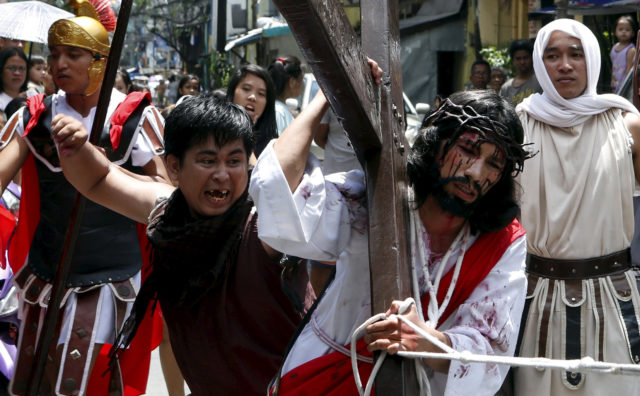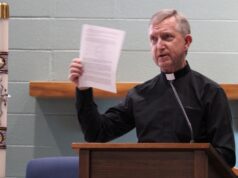
On Good Friday, Alvin Duazo spends three to five hours in prayer, reflection and confession.
“I start at around 8 a.m.,” said Duazo, 22, from a small town outside Cebu City in the central Philippines. “Because normally confession during that day is like lining up for a blockbuster movie so you’ve got to be early.”
After confession he spends a couple of hours at eucharistic adoration “praying on my knees.” Duazo follows that with Mass and finally hearing the “Siete Palabras,” the “Seven Last Words” (or phrases) of Jesus as he hung on the cross in the moments before his death.
Duazo explained to Catholic News Service that a priest leads reflections on each phrase and everyday people give testimonials of how God’s work in their lives reflects some aspect of the seven phrases.
In the predominantly Catholic Philippines, the Siete Palabras are broadcast on Good Friday over the country’s main Catholic radio network and on a mainstream television network. Other domestic networks start to go off the air on Maundy Thursday. Similar to Duazo’s local parish, the broadcasts that are produced by Dominican priests also have reflections but from some of the country’s prominent Catholic lay leaders.
Holy Week marks the start of summer vacation for elementary and high school students. It also marks the mass exodus from major cities like metro Manila and Cebu as residents return to their hometowns in the far-flung provinces across the country.
In these countryside towns, particularly on the island of Luzon, which includes the capital Manila, the “Pabasa” or nonstop recitation of the Passion begins on Palm Sunday and can continue through Good Friday.
“It is done in the form of a dirge-sounding, monotonous, lamentation,” said Father Lorenzo Ruggiero, a native of Italy who has served at churches in Luzon’s provinces as well as the capital Manila for more than 12 years.
Chanted in five-line stanzas at specific meters, intonations and inflections, Father Ruggiero told CNS these recitations are usually held at someone’s home but they could also take place on a street corner where anyone can join in for a few hours and then go about the rest of their day.
He said, “It is possibly the time in which people are able to interiorize God’s word and the very heart of the Gospels … which is the accounts of the Passion (and) death of Christ.”
Reenactments of the Passion are also a popular highlight of Holy Week in the Philippines. Some enthusiastic faithful scourge themselves and have themselves nailed to a cross, with the nails being driven through their hands and feet, inducing significant pain and loss of blood in what they believe are acts of penance.
But the church does not approve of this international tourist draw, which is practiced most prevalently in Pangasinan province northwest of Manila.
“Christ’s sacrifice on Calvary is a ‘once for all’ event that resulted in man’s redemption. No one can diminish its effect on humanity,” said Father Jerome Secillano, head of the public affairs commission of the Philippine bishops’ conference. “It is never to be repeated.”
After Easter Mass, the faithful enact an imagined meeting between the resurrected Jesus and his mother Mary.
Father Ruggiero said the “Salubong” or encounter originally called “Encuentro” involves men carrying a statue of the risen Jesus on one end and women carrying a statue of Our Lady of Sorrows on the opposite end.
The Mary statue usually has a black veil of mourning. The two statues approach each other and once they meet, a child dressed as an angel and suspended by wire swoops in and pulls the veil away, ushering in jubilant songs of praise.
Father Ruggiero said, “I love this religious tradition for its deeply ‘Filipino flavor.’ It reveals some of the most distinguishing traits of Filipino religiosity, namely deep silent devotion to the sorrows of Christ, unmatched love for ‘Mama Mary’ as the Blessed Mother is fondly called and, not the least, the joy of the Catholic faith expressed in the gift of community.”
— By Simone Orendain Catholic News Service
Orendain is a freelance journalist.








